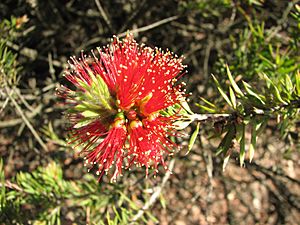Blackdown bottlebrush facts for kids
Quick facts for kids Blackdown bottlebrush |
|
|---|---|
 |
|
| Melaleuca pearsonii | |
| Scientific classification | |
| Genus: |
Melaleuca
|
| Species: |
pearsonii
|
| Synonyms | |
|
Callistemon pearsonii R.D.Spencer & Lumley |
|
The Blackdown bottlebrush, also known as Melaleuca pearsonii, is a special plant from the myrtle family. Its scientific family name is Myrtaceae. This plant is found only in Queensland, Australia. This means it is endemic to that area. Some plant collections in Australia still call it Callistemon pearsonii.
The Blackdown bottlebrush is a small, spreading shrub. It has tough bark and soft leaves. In spring and summer, it grows many bright bottlebrush-shaped flowers.
Contents
What the Blackdown Bottlebrush Looks Like
The Melaleuca pearsonii is a shrub that can grow up to 2 m (7 ft) tall and wide. It has hard, stringy bark.
Its leaves grow one after another along the stem. They are about 14–38 mm (0.6–1 in) long and 1.5–5 mm (0.06–0.2 in) wide. The leaves are flat and shaped like a narrow egg, with the narrower end at the base. You can't easily see the leaf veins. But you can see many small oil glands on the leaves.
The flowers are red with yellow tips. They grow in short spikes at the ends of branches. These branches keep growing even after the flowers bloom. Flowers also grow on the sides of the branches. Each flower spike is about 45–65 mm (2–3 in) across. Each spike has between 20 and 40 individual flowers. The petals are 3.7–5.7 mm (0.1–0.2 in) long. They fall off as the flower gets older. Each flower has 25 to 39 stamens, which are the parts that hold pollen.
This plant mainly flowers in spring. After flowering, it produces woody capsules. These are like small seed pods. The capsules are about 3.8–5.2 mm (0.1–0.2 in) long.
How it Got its Name
The plant was first officially named Melaleuca pearsonii in 2006. This happened when Lyndley Craven moved it into the Melaleuca group of plants. Before that, it was known as Callistemon pearsonii.
Roger Spencer and Peter Lumley first described it in 1986. They used plant samples from the Blackdown Tableland National Park. The second part of its scientific name, pearsonii, honors Steven Pearson. He was a park ranger at the Blackdown Tableland National Park.
The Royal Botanic Gardens, Kew considers Callistemon pearsonii to be the same plant as Melaleuca pearsonii.
Where the Blackdown Bottlebrush Lives
Melaleuca pearsonii is found only on the Blackdown Tableland in Queensland. It likes to grow near rivers and in rocky areas called gullies. You can also find it in sandy areas near creeks, which are sometimes called wallum vegetation.
Growing it in Gardens
Sometimes, people grow Melaleuca pearsonii in their gardens. It is often sold under its old name, Callistemon pearsonii. There is even a special type called "Rocky Rambler" that gardeners like to grow.

